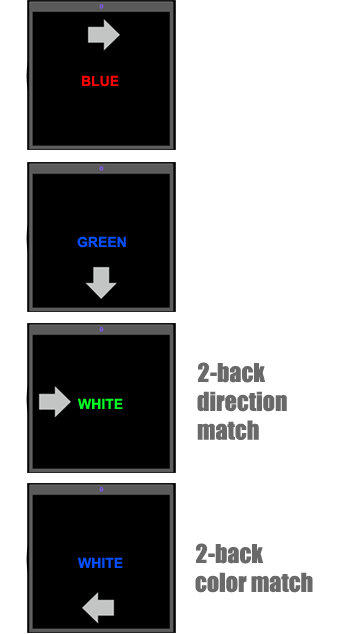In a study published last week (Oct 28, 2015) by Cohen and his colleagues in the journal Neuroimage, it has been shown that training on an implementation of HighIQPro’s ‘Stroop’ n-back game can can reduce the brain’s emotional reactivity by changing the brain’s wiring to make it less responsive to threatening information.
The principle of this brain training game is interference control.
What is interference control?
When distracting information conflicts with the task requirements, as shown here there is ‘interference’. Each arrow-word combination is presented in sequence to the player at 1-3 second intervals. The task here is to look for a ‘2-back’ match for the arrow direction or the ink color of the words, ignoring the arrow location and the word name.

If we look at the 2-back direction match, there is a conflict (‘interference’) with the spatial location. The location does not match while the direction does. To get this right we need to ignore the location. If we look at the 2-back color match we can see it conflicts with the actual color names ‘green’ and ‘white’. To get this right we need to ignore the word meanings, and just look at the color. Getting the right matches in this n-back game requires interference control – our ability to ignore conflicting information.
Interference control and IQ
It is known that there is a close link between interference control ability and IQ, and IQ Mindware builds in interference control to standard dual n-back training to optimize IQ increases.
Interference control and emotional reactivity
But this latest Cohen study looked at interference control training on emotional reactivity. Emotional reactivity is where emotionally charged information grabs your attention and slows down higher order cognitive functioning, such as good decision-making. Emotional reactivity is known to be a problem with individuals suffering from stress-related emotional dysregulation such as depression or anxiety.
We can measure how emotionally reactive someone is by flashing a picture of a threatening picture just before a colored square, and measuring the reaction time for naming the color. The more emotionally reactive, the slower the reaction time – because the ‘threat’ information draws attention and slows down the decision-making.

The results of 6 day’s training
The researchers looked at how 6 days of brain training (45 minutes per day) affected emotional reactivity in this reaction time task. Using fMRI they also looked at brain activity doing this task – both before and after the brain training.
They found that participants who did the interference training showed reduced activation in their amygdala – a brain region involved in emotions, including anxiety and fear – as a result of the brain training.
And the more their amygdala was calmed, the less their responses were slowed by scary pictures. In other words, the less distracted by threatening information and the better emotional regulation they had.
There was also evidence that, after the training there was increased connectivity between the amygdala and frontal cortex – the region involved in executive higher order cognition.
The researchers conclude, interference control training (implemented in HighIQPro)…
“can suppress emotional reactions, and thus might serve as a short-term and easy-to-implement treatment for individuals suffering from disorders characterised by emotion dysregulation.”

